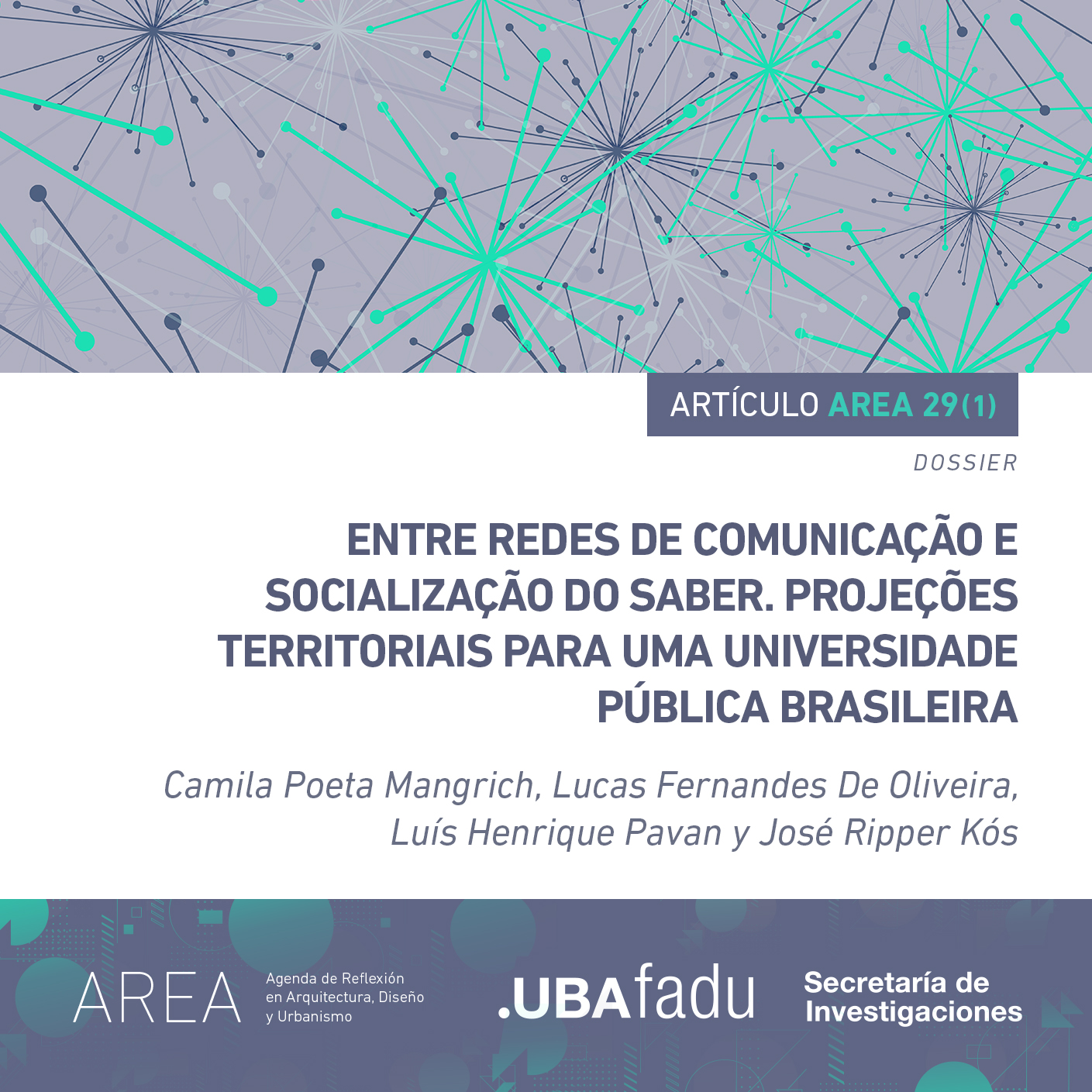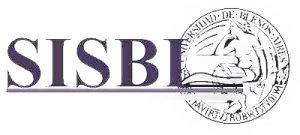Entre redes de comunicação e socialização do saber. Projeções territoriais para uma universidade pública brasileira
Palabras clave:
Campus universitário, Redes de comunicação, Espaço públicoResumen
Sedimentado sob intercâmbios com a estrutura político-pedagógica do Norte Global, o território universitário brasileiro possui subestimados potenciais de socialização do conhecimento e enfrentamento à crise climática. Através de experimentações visuais aplicadas ao contexto do Campus Trindade da UFSC, este artigo busca interseções entre o papel do espaço físico da universidade – como estruturas de transmissão do saber – com as tipologias de rede de comunicação, teorizadas por Paul Baran em 1964. Identifica-se nos diagramas uma latente disposição nas interações acadêmicas para atingir a resiliência de uma rede infraestrutural bem distribuída, ainda eclipsada pelos escassos recursos que distanciam universidade e sociedade.
Descargas
Citas
Atcon, R. P. (1970). Manual sobre o planejamento integral do campus universitário. Brasilia: Ministério da Educação e Cultura.
Adkins, A., Dill, J., Luhr, G., & Neal, M. (2012). Unpacking walkability: Testing the influence of urban design features on perceptions of walking environment attractiveness. [Arquivo PDF]. Journal of Urban Design, 17(4), pp. 499-510. DOI: http://dx.doi.org/10.1080/13574809.2012.706365
Anguelovski, I., Shi, L., Chu, E., Gallagher, D., Goh, K., Lamb, Z., … e Teicher, H. (2016). Equity impacts of urban land use planning for climate adaptation: Critical perspectives from the global north and south. Journal of Planning Education and Research, 36(3), pp. 333-348.
Baran, P. (1964). On distributed communications networks. IEEE transactions on Communications Systems, 12(1), pp. 1-9.
Bodó, B., Brekke, J. K. e Hoepman, J. H. (2021). Decentralisation: a multidisciplinary perspective. Internet Policy Review, 10(2), pp. 1-21.
Brown, J. S. e Duguid, P. (1996). Universities in the digital age. Change: The Magazine of Higher Learning, 28(4), pp. 11-19.
Brownson, R. C., Hoehner, C. M., Day, K., Forsyth, A. e Sallis, J. F. (2009). Measuring the built environment for physical activity: state of the science. American journal of preventive medicine, 36(4), pp. S99-S123.
Buffa, E. e Pinto, G. D. A. (2016). O território da universidade brasileira: O modelo de câmpus. Revista Brasileira de Educação, (21), pp. 809-831.
Crutzen, P. J. e Stoermer, E. F. (2000). The Anthropocene. [Arquivo PDF]. IGBP newsletter, (41), pp. 17-18. Recuperado de http://www.igbp.net/publications/globalchangemagazine/globalchangemagazine/globalchangenewslettersno4159.5.5831d9ad13275d51c098000309.html
Dardot, P. e Laval, C. (2014). Commun: essai sur la révolution au XXIe siècle. París: La découverte.
El-Borsh, S. H., El-Mewafi, M. e Zarzoura, F. (2017). Studying and evaluating the development axis in damietta governorate based on Geographic Information System (GIS). International Journal of Scientific & Engineering Research, 8(8), pp. 1726-1736.
Ewing, R. e Cervero, R. (2010). Travel and the built environment: A meta-analysis. [Arquivo PDF]. Journal of the American planning association, 76(3), pp. 265-294. DOI: https://doi.org/10.1080/01944361003766766
Haase, D., Kabisch, S., Haase, A., Andersson, E., Banzhaf, E., Baró, F., Brenck, M., et al. (2017, junio). Greening cities – To be socially inclusive? About the alleged paradox of society and ecology in cities. [Arquivo PDF]. Habitat International, 64, pp. 41-48. DOI: https://doi.org/10.1016/j.habitatint.2017.04.005
Hajrasouliha, A. H. (2017). Master-planning the American campus: Goals, actions, and design strategies. Urban Design International, 22(4), pp. 363-381.
Kós, J. R., Pavan, L. H. e Mangrich, C. P. (2020). The civic potential of the campus: Federal University of Santa Catarina and democracy in the city. [Arquivo PDF]. Arquitecturas Del Sur, 38(58), pp. 80-97. DOI: https://doi.org/10.22320/07196466.2020.38.058.05
Latour, B. (2018). Down to earth: Politics in the new climatic regime. Cambridge: Polity Press.
Loukissas, Y. A. (2019). All data are local: Thinking critically in a data-driven society. Cambridge: The MIT Press.
Lyster, C. (2016). Learning from Logistics. Basilea: Birkhäuser.
Mangrich, C. P., Pavan, L. H., Gomes, F., Oliveira, L., Kós, J. e Martina, J. E. (2019). Campus regenerative design supported by university Wi-Fi connections. [Arquivo PDF]. International Journal of Architectural Computing, 17(2), pp. 206-219. DOI: https://doi.org/10.1177/1478077119849682
Oliveira, L. F. de, Mangrich, C. P., Pavan, L. H., Almeida, R. L. M. de e Kós, J. R. (2021). University campus walkability index supported by digital databases. [Arquivo PDF]. Blucher Design Proceedings, pp. 303-314. DOI: https://doi.org/10.5151/sigradi2021-263
Owens, C. (1980). The allegorical impulse: Toward a theory of postmodernism. October, 12, pp. 67-86.
Passos, J. (2015). Relações raciais, cultura acadêmica e tensionamentos após ações afirmativas. Educação em Revista, (31), pp. 155-182.
Pavan, L. H., Oliveira, L. F. de, Mangrich, C. P., Almeida, R. L. M. de, Gomes, F. de O., Martina, J. E. e Kós, J. R. (2022). Dados de conexão Wi-Fi e campus universitário: Estudos sobre dinâmica humana e privacidade. [Arquivo PDF]. Gestão & Tecnologia de Projetos, 17(1), pp. 185-198. DOI: https://doi.org/10.11606/gtp.v17i1.183687
Pedroso, F. (2019). Relação do campus com a cidade: A interdependência dos limites do campus Trindade da UFSC a partir da concepção de projetos regenerativos [Dissertação de mestrado, Universidade Federal de Santa Catarina].
Pereira, F. T. (2017). Exporting progress: Os norte-americanos e o planejamento do campus no Brasil. [Tese]. San Pablo: Universidade de São Paulo.
Pimenta, L. F., Andrade, M. A. de C., Pimenta, M. de C. A. e Eller, M. (1998). Plano diretor físico: Diagnóstico geral. Florianópolis: Editora da UFSC.
Pinto, G. e Buffa, E. (2009). Arquitetura e educação: Câmpus universitários brasileiros. San Carlos: EdUFSCar.
Segawa, H. (2012). Architecture of Brazil: 1900-1990. Berlín: Springer Science & Business Media.
Standaert, N. (2012). Towards a networked university [pp. 99-112]. Em R. Barnet (Ed.), The Future University. Ideas and Possibilities. Londres: Routledge.
Schwanen, T. e Nixon, D. V. (2020). Understanding the relationships between wellbeing and mobility in the unequal city: The case of community initiatives promoting cycling and walking in São Paulo and London [pp. 79-101]. Em M. Keith e A. A. de Souza Santos (Eds.), Urban transformations and public health in the emergent city. Manchester: Manchester University Press.
Tassone, V. C., O’Mahony, C., McKenna, E., Eppink, H. J. e Wals A. E. J. (2018). (Re-)designing higher education curricula in times of systemic dysfunction: A responsible research and innovation perspective. [Arquivo PDF]. Higher Education, 76(2), pp. 337-352. DOI: https://doi.org/10.1007/s10734-017-0211-4
Tsing, A. L., Swanson, H., Gan, E. e Bubandt, N. (Orgs.). (2017). Arts of living on a damaged planet. Minnesota: University of Minnesota Press.
Universidade Federal de Santa Catarina-UFSC. (1981). Jornal Universitário, 34. Telefone, Água, Jardins. Florianópolis: Editora da UFSC.
Van der Zwaan, B. (2017). Higher education in 2040. A global approach. Amsterdam: Amsterdam University Press.
Vechia, A. e Gomes Ferreira, A. (2020). Brazilian Higher Education in the 1960s and 1970s of the 20th century: International agreements and the reform of the brazilian university. Encounters in Theory and History of Education, (21), pp. 134-155.
Verger, J. (1990). As universidades na idade média. San Pablo: Editora Unesp.
Winner, L. (1980). Do artifacts have politics? Daedalus, 109(1), pp. 121-136.

Descargas
Publicado
Cómo citar
Número
Sección
Licencia

© 1992-2025 – Revista AREA, su sitio, contenidos y metadata están bajo licencia de Acceso Abierto CC BY-NC-ND 2.5 AR







